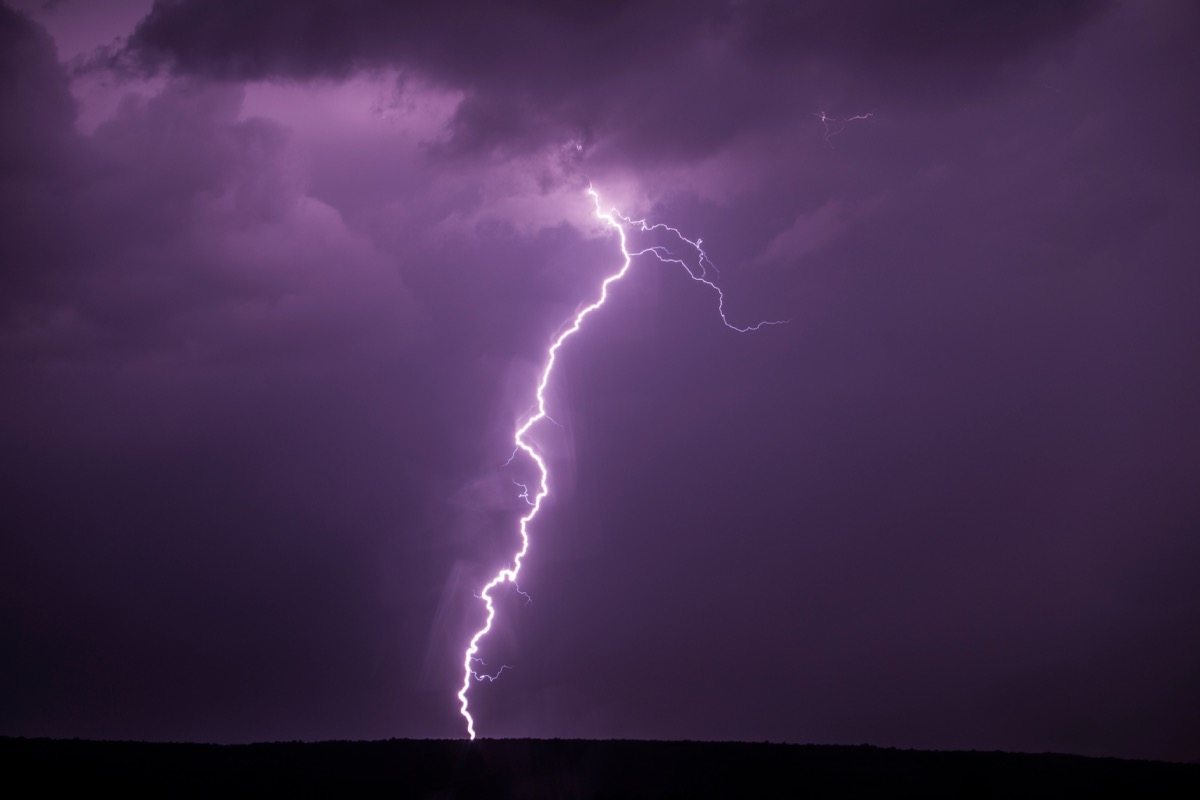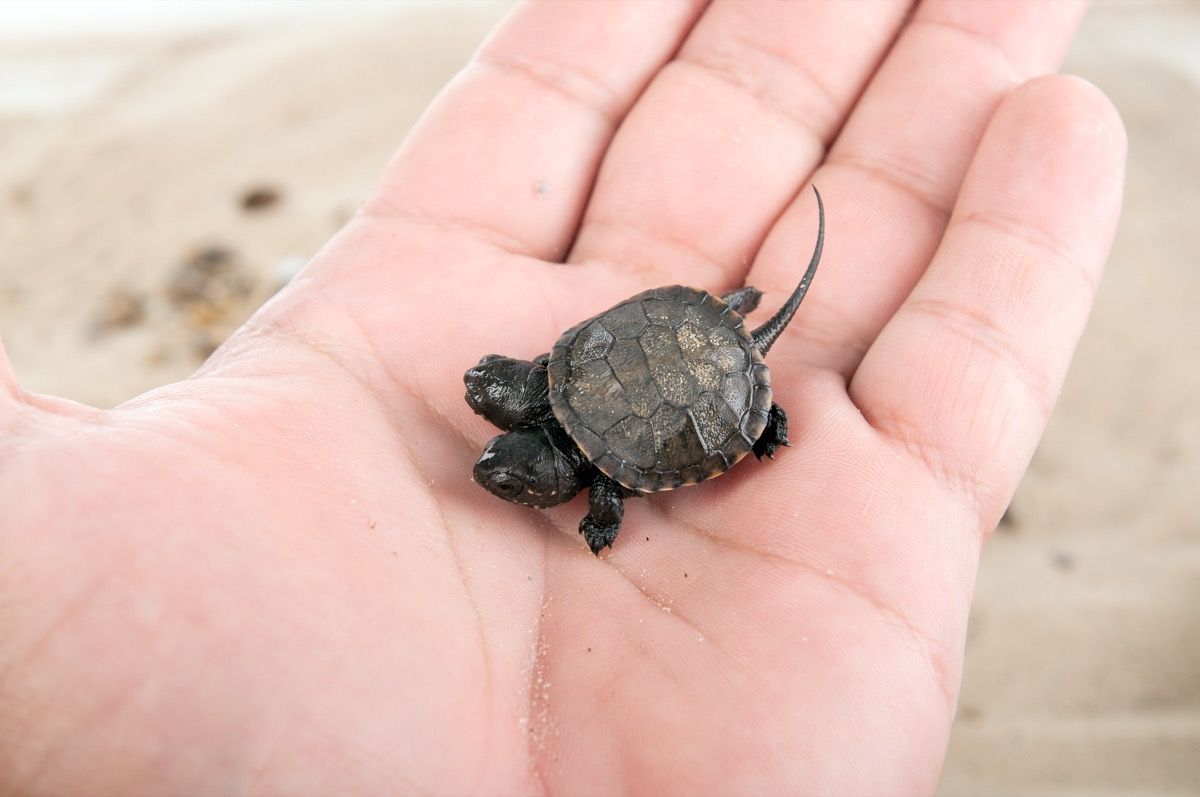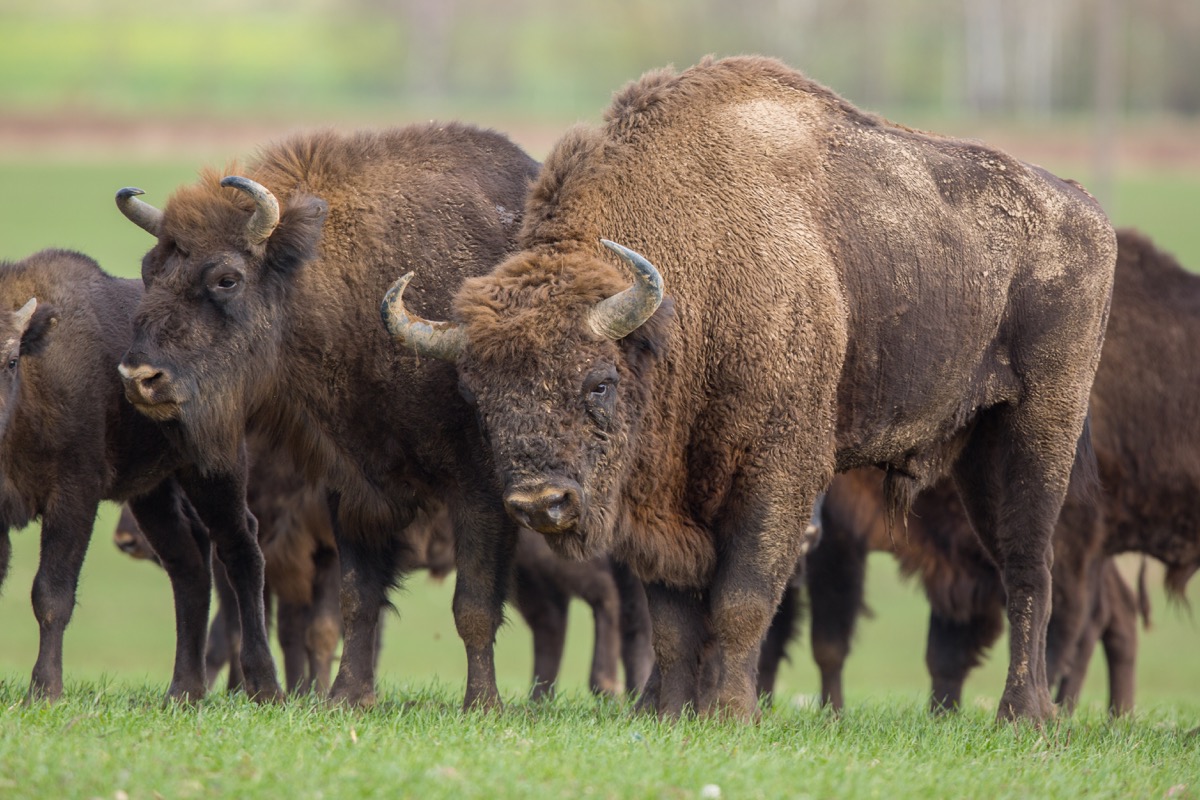50 “Rare” Events That Happen All the Time

Have you ever met a stranger with your birthday and thought, “What are the odds?” Or maybe you heard about someone you know getting struck by lightning and couldn’t quite believe their bad luck. In fact, there are plenty of occurrences that actually happen quite often, but that we think of as being extremely unlikely. The following surprising facts will help you set the record straight: Here are 50 “rare” events that actually happen all the time. And for more mind-blowing trivia, check out these 50 Absurd Facts That Will Make You Question Everything.
1
A Total Solar Eclipse

While a total solar eclipse might seem like a once-in-a-lifetime experience, they aren’t terribly uncommon. According to Space.com, “It is a popular misconception that the phenomenon of a total eclipse of the sun is a rare occurrence. Quite the contrary. Approximately once every 18 months (on average) a total solar eclipse is visible from someplace on the Earth’s surface.” And for more misconceptions to dispel, 50 Well-Known “Facts” That Are Actually Just Common Myths.
2
Getting Struck by Lightning

Be sure to head inside the next time a storm rolls in, because being struck by lightning is not that uncommon. The odds of being struck in your lifetime are 1 in 3,000, according to National Geographic. Fortunately, the National Weather Service reports that just 10 percent of people who are struck by lightning are killed.
3
Shooting Stars

Shooting stars occur when small rocks in space collide with Earth’s atmosphere and burn up in a blazing display of light. And while that might seem like it doesn’t happen every day, it actually occurs a few times every hour. According to the Astronomy Department at Cornell University, you can expect to see a shooting star every 10 to 15 minutes when stargazing in clear skies. And for more trivia to keep you entertained, try these 35 Fascinating Fast Facts for When You’re Bored.
4
Volcanic Eruptions

You might think volcanic eruptions are incredibly rare events that would cause the entire world to take notice. But it turns out, there are typically about 50 to 60 volcanoes that erupt each year on Earth (that’s about one every week). Part of why these eruptions seem uncommon is that they’re hardly ever the massive kind we see on TV and in the movies. In many cases, it’s difficult to even identify the start and end of an eruption.
5
A Blue Moon

“Once in a blue moon” makes the event sound particularly unlikely. But a blue moon—which is when two full moons fall within the same month or when an extra full moon takes place during a single season—actually occurs around every 2.5 years, according to NASA.
6
Living to 100

More people are living to 100 than ever before. According to a 2011 report from the U.K.’s Department for Work and Pensions, 20-year-olds today are twice as likely to reach 100 as their parents and three times more likely than their grandparents. The report also found that girls born in 2011 have a 1 in 3 chance of living to 100, while boys have a 1 in 4 chance. And for more good news, check out these 50 Feel-Good Facts Guaranteed to Make You Smile.
7
Meeting a Stranger With Your Birthday

Meeting someone with the same birthday as you is always exciting, but it isn’t exactly rare. In fact, it’s pretty much guaranteed to happen in certain circumstances. “Mathematicians call this ‘the birthday problem,’ and they usually phrase it like this: How big of a group of people do you have to assemble before there’s a 50-50 chance that two of the people share the same birthday?” Ana Swanson explains for The Washington Post.
“If you assemble a group of 366 people, there’s 100 percent probability that two people will have the same birthday—since there are only 365 days in a year, excluding leap years,” she continues. “But the probability is still almost certain with a much smaller group than that.” In a group of 60 people, it’s extremely likely that two people will share a birthday.
8
Dying on Your Birthday

There may be a bigger reason to fear your birthday than the simple fact that you’re getting older. One 2012 study published in the Annals of Epidemiology found that people are 14 percent more likely to die on their birthday than on any other day of the year. And while there are a few theories as to why this is the case, there’s no clear cause. And for more shocking trivia, here are 50 Absurd Facts That Sound Made Up.
9
Surviving a Plane Crash

Rest assured that being in a plane crash is rare. “If you take one flight a day, you would on average need to fly every day for 55,000 years before being involved in a fatal crash,” M.I.T’s Sloan School statistician Arnold Barnett told ABC News.
But if you do have to be involved in a plane crash, surviving one is more likely than you might’ve believed. Turns out, the survivability rate is an incredible 95.7 percent, according to the National Transportation Safety Board.
10
Falling to Your Death

You might want to hold the rail on stairs, put a mat down in your shower, and stay away from cliffs. That’s because we all have a 1 in 218 chance of falling to our deaths, according to the National Safety Council. And for more fascinating content delivered straight to your inbox, sign up for our daily newsletter.
11
Being Color Blind

You probably run into someone who can’t see the entire color spectrum at least once a week. Color blindness affects around 1 in 12 men and 1 in 200 women.
12
Being a Twin

From around 1915 to 1980, about 1 in every 50 babies was a twin, a rate of 2 percent, according to The Atlantic. By 1995, that rate was 2.5 percent, and in 2010, it was 3.3 percent. That means that nowadays, 1 in every 30 babies is a twin.
Parents explains that “two-thirds of the increase is likely due to the growing use of IVF,” while the rest is “mainly attributed to a rise in the average age women give birth,” since older women are more likely to conceive twins.
13
Giving Birth on the Way to the Hospital

We all know babies don’t tend to arrive exactly when they’re due. Sometimes, the little ones just can’t wait to make their big debut. That’s why, according to an Australian study of data collected between 2000 and 2011—published in the journal BMJ Open in 2018—4.6 in every 1,000 babies are born before their moms get to the hospital.
14
Being Born With an Extra Finger or Toe

Most people have both five fingers on each hand and five toes on each foot. But being born polydactyly, as it’s technically called, isn’t all that rare. In the United States, 1 out of every 500 to 1,000 babies has an extra finger or toe, according to the Boston Children’s Hospital.
15
Being Ambidextrous

Are you right-handed or left-handed? Or are you a little bit of both? According to the American Psychological Association, 1 in every 100 people is born with “true” ambidexterity, which means they have no dominant hand at all.
16
Being Born With Teeth

Most babies get their first tooth between four and six months old. However, there are cases when a newborn arrives with teeth. While almost 4 million babies are born in the U.S. each year, according to the Centers for Disease Control and Prevention (CDC), 1 in every 2,000 of those little ones is born with what are called “natal teeth.”
17
Being Born Without a Kidney

Humans only need one kidney to survive. As such, it’s possible for a baby to be born without one and have zero complications whatsoever. According to the Children’s Hospital Colorado, this condition—known as renal agenesis—occurs in about 1 in every 3,000 to 4,500 births and is more common in boys.
18
Being Born With Albinism

While only 1 in every 17,000 to 20,000 people are born with albinism in Europe and the United States, it’s much more common in other places around the world. For instance, in sub-Saharan Africa, the condition affects 1 in every 5,000 to 15,000 people, according to the UN World Health Organization. In some groups, as many as 1 in 1,000 to 5,000 babies are born with albinism.
19
Being Born With a Tail

Although humans being born with tails isn’t exactly common, it’s also not impossibly rare either. There have been 23 cases of true vestigial tails reported since 1884. According to the Annals of Plastic Surgery, “Vestigial tails contain adipose and connective tissue, blood vessels, and nerves and are covered by skin. Bone, cartilage, notochord, and spinal cord elements are lacking.”
20
Having Royal Blood

Plenty of people have dreamed about learning they’re secretly royals. And it turns out they probably are, according to Popular Science.
Consider that, if you go back 30 generations, you have a staggering 1.073 billion ancestors. “There were fewer people on the planet to have been descended from than there are today, [so] you can easily see how pretty much everyone is related to royalty at some point,” explains IFL Science.
21
Winning the Lottery

While winning a massive jackpot might be unlikely, it’s actually quite common to win one of the smaller prizes. “The real money is made in the trenches of the pick-3, pick-4, and pick-5 game,” Steve Player, a lottery expert, told Forbes. Player says he has won two major jackpots, the New York Pick-6 Lotto, and the Florida Fantasy Five, as well as prizes in 27 states while also holding the records for the highest single-day payouts on pick-3 and pick-4 numbers. This is all to say, it’s clearly not all that uncommon to win big.
22
Experiencing Déjà Vu

Déjà vu—when it feels like you’re reliving a certain moment you can’t quite place—is estimated to occur in 60 to 80 percent of the population, according to research from Texas A&M University. As the American Journal of Psychiatry notes, “The déjà vu experience is a common phenomenon. It has been defined as any subjectively inappropriate impression of familiarity of a present experience with an undefined past.”
23
Finding a Two-Headed Animal

While two-headed animals are “still rare enough to surprise us,” they’re not really all that rare, according to ABC News. “This eye-catching developmental abnormality—known as bicephaly or dicephaly—is a phenomenon that has been around for at least 150 million years,” the news outlet reports. And there have been cases involving numerous creatures, from snakes to bulls, sharks to turtles, and prawns to kittens.
24
Discovering a New Species

There’s a lot we still don’t know about Earth—and that includes how many other creatures live on it with us. One 2011 paper published in PLOS Biology revealed that “some 86 percent of existing species on Earth and 91 percent of species in the ocean still await description.” While that might seem like a daunting percentage, we happen to be finding those species at an incredible rate. Around 15,000 to 20,000 new species are cataloged every year, according to the BBC.
25
Hitting a Home Run

Hitting a home run may not be an easy endeavor for the average athlete, but it’s becoming more and more common in the big leagues. According to SB Nation, “balls are flying out of parks at a record rate.” They report that baseball players in the MLB set a record in May 2019 with 1,135 home runs and then beat that record the following month with 1,142 home runs.
26
Catching a Foul Ball

The next time you head to the ballpark, be sure to take your glove with you. It turns out, your odds of catching a foul ball are pretty good: 1 in 835 at an MLB game. One lucky fan even caught two foul balls in a row at a 2018 Oakland A’s game.
27
Summiting Mount Everest

Not everyone is physically or mentally capable of reaching the top of Mount Everest—but it turns out, plenty of people are. In fact, so many climbers attempted to tackle the formidable feat in 2019 that there were deadly traffic jams on the mountain. Nepal’s Department of Tourism reported that in the spring season, 563 climbers from 39 different countries successfully reached the summit from the Nepal side.
28
Writing a New York Times Best Seller

When you see that a book is a New York Times Best Seller, you might think that it’s part of an elite group of literature. But writing a book that ends up on the coveted Times list is more common than you might’ve imagined. Statistics whiz Gregory Baer, author of Life: The Odds, told The Boston Globe that if you’re already a published author, your odds are 1 in 220.
29
Winning an Academy Award

Winning an Academy Award is a prestigious industry honor. However, it’s also one that thousands of people who work as actors, directors, costume makers, set designers, and more have won. As of 2020, a total of 3,140 people have taken home Oscar awards, with dozens more given out every year.
30
Playing Professional Basketball

Playing basketball professionally may seem like a lofty career goal, but it’s actually pretty achievable—if you play college ball, that is. According to the NCAA, 21.3 percent of college players will go pro.
31
Electing a Woman Head of State

The U.S. may not have had its first female president yet, but plenty of other countries have—in fact, 59 countries have had a woman leader.
32
Experiencing Love at First Sight

Love at first sight is a sweet phenomenon that seemingly only happens for a lucky few. But in reality, fairytale romances are more common than they seem. After all, one 2013 poll found that 56 percent of Americans believe in love at first sight.
33
Dating a Millionaire

It turns out, there are a lot more millionaires in the dating pool than you might have thought. Baer said that the chances that the person you’re dating is a millionaire are 1 in 216. Part of those odds might be due to the fact that the number of millionaires is rising. In 2018, there were 11.8 million households in the United States with a net worth of more than $1 million, according to a 2019 report by research firm Spectrem. That’s an impressive 3 percent of the population.
34
Being Audited by the IRS

Unfortunately, you’re far more likely to have to deal with the government tax pros than you might have thought. According to IRS data, you have a 1 in 160 chance of being audited. Better check those numbers again before you file your next return!
35
Being Arrested

For many law-abiding citizens, getting arrested probably doesn’t sound like it happens too often. But according to the Brennan Center for Justice, 1 in 3 Americans will have been arrested by age 23. In fact, just as many Americans have criminal records as college diplomas.
36
Being Wrongfully Convicted of a Crime

Being completely innocent won’t always prevent you from being convicted of a crime. “Supreme Court Justice Antonin Scalia cited the odds of a wrongful conviction at about … 1 in 3,703,” according to The Las Vegas Review-Journal. The journal also explains that “University of Michigan law professor Samuel Gross guesses that there’s about a 4.1 percent error rate among convictions that end in death sentences—that’s 1 in 24.”
37
An Asteroid Hitting the Earth’s Atmosphere

There are so many objects flying around in space, which means our planet can’t always avoid getting hit. According to NASA, “About once a year, an automobile-sized asteroid hits Earth’s atmosphere, creates an impressive fireball, and burns up before reaching the surface.”
38
A Meteor Reaching Earth’s Surface

Every year, thousands of meteors also hurtle towards Earth and (thankfully) most of them burn up in our planet’s atmosphere before they can do any major damage to the surface below. However, around 6,100 do manage to reach the ground. That means that every day, 17 new meteors make it to our planet.
39
Finding a Shipwreck

You might think shipwrecks are the stuff of movies and legends, but if you had a high-tech shipwreck detection machine, you’d actually find a lot. James Delgado, director of the Maritime Heritage Program at the National Oceanic and Atmospheric Administration, estimates that there are a million shipwrecks underwater now. “Given everything that’s charted and all the rest, I would say that the majority of them remain undiscovered,” he told Popular Mechanics.
40
Ghost Sightings

Whether or not you believe in ghosts, there’s likely someone around you who does—and believes they’ve seen one. According to a 2015 Pew Research Center survey, 1 in 5 adults in the United States say they’ve either seen or have been in the presence of a ghost.
41
UFO Sightings

Seeing a ghost isn’t the only mysterious phenomenon that occurs more often than you might expect. From 1947 to 1969, the U.S. government investigated 12,618 reported UFO sightings. And while most could be explained by weather-related phenomena, 701 cases could not be resolved, according to the National Archives.
42
Crashes Caused By Drunk Drivers

Mothers Against Drunk Driving (MADD) provides some pretty scary statistics about drunk driving. Every day, there are more than 300,000 incidents of drinking and driving. In 2017 alone, 10,874 people died in drunk driving crashes.
43
Calling 911 When There Isn’t an Emergency

Being able to call 911 when you’re in dire need of help is incredibly important, but there are a lot of people who use the service for circumstances that aren’t true emergencies. In 2016, San Francisco alone fielded 257,000 911 calls that weren’t emergencies out of about 1.2 million calls that year.
44
Exposure to Gamma Rays

What you probably know about gamma rays is that Marvel’s fictional Hulk character transformed into the big green monster-like version of himself courtesy of the stuff. So who could blame you for thinking that exposure to gamma rays is super rare? But in reality, humans come into contact with this type of radiation quite often.
The American Cancer Society (ACS) explains that both “X-rays and gamma rays can come from natural sources, such as radon gas, radioactive elements in the earth, and cosmic rays that hit the earth from outer space.” However, there are also man-made sources. “X-rays and gamma rays are created in power plants for nuclear energy, and are also used in smaller amounts for medical imaging tests, cancer treatment, food irradiation, and airport security scanners,” the ACS adds.
45
Finding a Worm in an Apple

According to the Agriculture and Natural Resources Department at the University of California, the codling moth— which isn’t actually a worm, but a caterpillar—is “a common and serious pest in … home-grown apples, pears, and even in walnuts.” In short, bite with caution!
46
Getting Food Poisoning

The next time you’re questioning an expiration date or taking a chance on a less-than-reputable restaurant, you might want to consider just how common food poisoning is. According to the U.S. Department of Health & Human Services, “the Federal government estimates that there are about 48 million cases of foodborne illness annually—the equivalent of sickening 1 in 6 Americans each year. And each year these illnesses result in an estimated 128,000 hospitalizations and 3,000 deaths.”
47
Being Born on Leap Day

Since Feb. 29 only happens once every four years and there are 365 days in each year, you might think that the chances of being born on a leap day are nearly impossible. But while your odds aren’t amazing, you do have a 1 in 1,461 chance of being born on Feb. 29, according to the BBC.
48
Finding a Four-Leaf Clover

Despite the fact that there’s typically just one four-leaf clover for every 10,000 three-leaf ones, the sheer volume of clovers in every patch means you’re more likely to find one than you might think. In fact, one Australian woman who went looking for the supposed lucky charms found 21 four-leaf clovers in her front yard alone.
49
Sun Showers

While sunny rain doesn’t sound like it would happen too often, The New York Times points out that “there’s always a place somewhere on this planet where you can stumble upon this magical weather paradox.” Sun showers are so frequent in Hawaii, for example, there are forecasts for them specifically in local weather reports.
50
Finding the End of a Rainbow

According to legend, if you locate the end of a rainbow, you’ll also be fortunate enough to find a leprechaun’s pot of gold. And while it would indeed be a rare occurrence to find the treasure trove of a mythical sprite, spotting the end of a rainbow isn’t so unusual. The experts at Weather.com explain that “rainbows are formed when water droplets in the atmosphere refract, or bend, sunlight in just the right circumstances. But you, as the observer, have to catch them just from the right angle and point of view as well in order to see them.” That means that despite being able to see the end of the rainbow, you can’t reach it because as you move closer, it will appear to move away.
However, the weather experts add, “depending on how you look at it, it could also mean that there are an infinite number [of rainbows] in the sky when the conditions are just right. You could be standing at the end of a rainbow right now!” Mind. Blown.